Salvias
BackSalvias are much loved for their colourful tubular flowers which last for many months attracting birds, bees and other beneficial insects and that can be used as cutflowers. They’re tough, reliable plants with hundreds of different species that can be found growing from the tropics right through to alpine mountains so there’s bound to be many that will thrive in your garden.
Whilst this growing guide focuses on the ornamental salvias there are also well know edible types. These include sage (Salvia officinalis), chia seeds (Salvia hispanica) and even rosemary (Salvia rosmarinus) which has been reclassified into the Salvia genus.
How to Grow Salvias
With such a diverse group of plants it’s not surprising that their growing requirements can differ greatly. To simplify things we’ve grouped salvias into three categories:
- Annuals
- Tropical and Subtropical
- Mediterranean
In addition to all the hundreds of species there are also many cultivars. What this means is you can find a salvia in just about any size (from 20cm to 4m) and that can handle just about any situation including frost, drought, heat and tropical humidity.
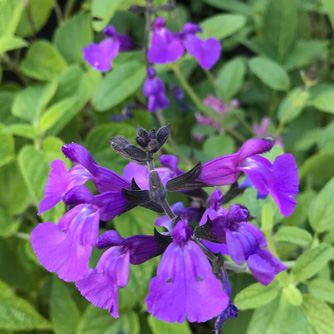
Salvia 'So Cool Violet'
1. Annual Salvias
Salvias sold as annuals are dwarf forms and can actually live for up to two years in warmer areas. In Mediterranean and cooler climates they are best treated as annuals. The most popular are forms available are:
- Mealy sage (Salvia farinacea) – commonly sold as ‘Victoria Blue’ or ‘Victoria White’ with white or blue flower spikes.
- Dwarf scarlet sage (Salvia splendens) – the hot red variety is the best known but there are also varieties with purple, white, salmon, pink, and bicolored flowers available.
- Painted sage (Salvia viridis) – has tiny flowers but prominent colourful bracts which can be purple, pink or white.
All can be planted as individual plants in pots or garden beds but they do look spectacular when mass planted. They love the warmth so they are mostly planted in spring and early summer. Planting times can be extended in areas which have warm winters.
Annual salvias can be grown in poor soil but will perform best if you work in some compost or manure beforehand. If drainage is poor then apply gypsum. Plant in full sun to part shade and water in with OCP eco-seaweed to reduce transplant shock and stimulate root development. Mulch to conserve water loss and reduce weed growth.
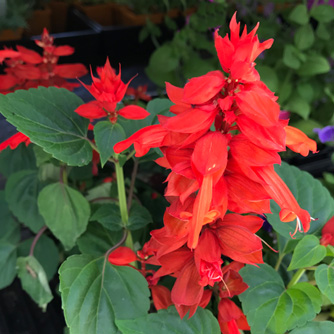
Unmissable Salvia splendens!
Fertilising and Maintaining Annual Salvias
Feed plants every 2-4 weeks with a combination OCP eco-seaweed and OCP eco-aminogro to promote lush plants and lots of flowers.
To stimulate new flowers remove the flower spikes after they fade and keep up the liquid feeding. In warm climates if S. farinacea gets too leggy you can cut it back to ground level to facilitate a flush of new growth and reblooming.
2. Tropical and Subtropical Salvias
About half of the salvia species come from the Americas and are mostly perennials suited to hot and humid climates. Coming from regions with more moisture they often have larger softer leaves with many being frost sensitive. Some popular varieties are:
- Tropical or scarlet sage (Salvia coccinea) – grown as an annual in cooler climates or a short-lived perennial in warmer ones. Grows to 1m with spikes of red, pink or white flowers. Self seeds readily.
- Salvia chiapensis – olive-green leaves, 40-60cm tall with year-round, cerise-pink flowers.
- Pineapple sage (Salvia elegans) – fruity-scented leaves, growth to 1.5m tall and narrow, scarlet-red flowers from spring to autumn.
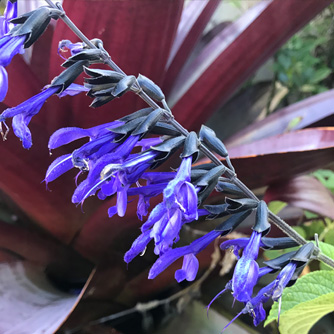
Salvia 'Black and Bloom' is just stunning
- Germander sage (Salvia chamaedryoides) – grows from 30-50cm tall with a running rootstock and small grey foliage. Blue flower spikes from spring to autumn. Drought and frost tolerant.
- Autumn sage (Salvia greggii) – grows 30-90cm tall with leathery leaves and flowers in red, pink, purple and white in summer to late autumn. Drought and frost tolerant.
- Salvia guaranitica – a lightly suckering perennial with spectacular flower spikes in summer and autumn. Well known forms are ‘Black and Blue’ and ‘Black and Bloom’ both with blue flowers and almost black calyces. Another is ‘Costa Rica’ with violet-blue flowers.
- Salvia mexicana – grows up to 3m with heart-shaped leaves and purple flowers that emerge from green calyces. ‘Limelight’ is a popular form.
- Little-leafed sage (Salvia microphylla) – a long flowering plant which is frost and drought tolerant. It grows to 1.2m tall and has blackcurrant scented leaves that can be hedged. Flowers can be red, white and pink flowers. The most popular is ‘Hot Lips’ which has two-toned red and white flowers. There’s also the ‘So Cool’ cultivars which are available in several colours including violet and purple.
- Bog sage (Salvia uliginosa)- needs moist soil and spreads by underground runners. Grows 90cm-1.5m tall with spikes of beautiful sky blue flowers from summer to autumn.
Whilst this group of salvias look great mass planted they are often grown as individual plants in garden beds. Smaller types will also perform well in pots.
Like annual salvias they can be grown in poor soil but will perform best if you work in some compost or manure beforehand. If drainage is poor then apply eco-flo gypsum. Plant in full sun to part shade and water in with eco-seaweed to help them establish faster. Mulch around the plants.
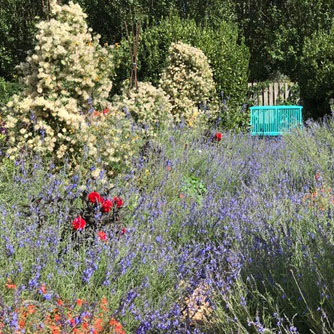
A lovely mass planting of Salvia azurea
Fertilising and Maintaining Tropical and Subtropical Salvias
Young plants can be fed every 2-4 weeks with OCP eco-seaweed and OCP eco-aminogro to encourage growth and flowers. Once established apply a handful of organic fertiliser pellets or dressing of compost/manure every 3 months from spring to autumn. Keep them well mulched.
Throughout the warmer months prune off individual spent flower heads to encourage more spikes. Alternatively you can cut back the entire bush by about a third after the first spring flush starts to fade. In autumn some of the smaller leaf varieties will be looking scraggly and benefit from another all over prune to remove spent spikes and encourage dense growth.
Some varieties will become semi-herbaceous which means in late autumn and winter their foliage may start to look a bit sad with some leaf drop. Then in late winter and early spring you’ll see new growth start to appear from the base of the plant. Plants which behave this way can be pruned hard to the ground and will develop lovely fresh growth in spring.
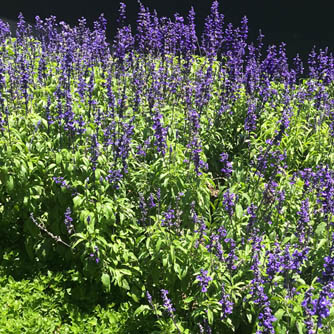
The purple annual Salvia farinacea
3. Mediterranean Salvias
Salvias in this group are generally very waterwise as they come from areas with dry summers like southern Europe, northern Africa, the west coast of the US and Mexico. They often have smaller leaves and are mostly frost hardy. Some examples of this group are:
- Canary Island Sage (Salvia canariensis) – grows to 2m tall with hairy grey-green leaves, lilac pink flowers and purple-red calyces in spring and summer.
- Salvia argentea – has large silvery woolly leaves which hug the ground and candelabra-like stems of white flowers in its second year. Often short-lived if allowed to produce seed.
- Brown salvia (Salvia africana-lutea, syn. S. aurea) – from South Africa, growing 90cm-1.5m tall with greyish-green leaves. Produces whorls of yellow flowers fading to orangey-brown in summer and autumn with prominent greenish-brown calyces.
- Velvet sage or Mexican bush sage (Salvia leucantha) – has woolly stems and narrow dull green leaves, thickly felted beneath. Grows to 1m tall with spikes of white, pink or purple flowers and showy velvety-purple calyces in late summer.
- Prairie sage (Salvia azurea) – produces long stems with sky blue flowers in summer to late autumn. Reaches 80cm tall.
Again these types can be planted individually as feature plants or massed together to put on a great show. Small growing varieties will happily thrive in pots.
This group is the most tolerant of poor quality soils but will still appreciate some compost or manure dug in before planting. They must have good drainage so apply gypsum if drainage is an issue. Plant in a full sun position and water them in with eco-seaweed. Mulch afterwards.
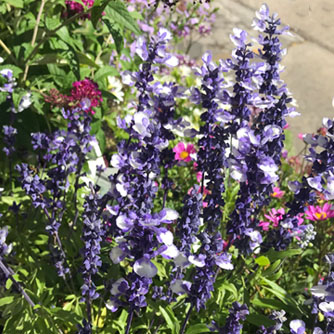
Two-toned Salvia farinacea
Fertilising and Maintaining Mediterranean Salvias
These can be treated the same as the tropical and subtropical varieties when it comes both fertilising and pruning so refer to that section above.
How to Propagate Salvias
Seed
In spring or summer sow salvia seeds onto the surface of punnets filled with potting mix. Do not cover the seed as it requires exposure to light to germinate. Water with eco-seaweed.
Cuttings
In spring, autumn and winter take 10cm cuttings of large leaf varieties. For other varieties take spring cuttings. Choose young growth with flexible stems that have not hardened and cut immediately below a node (the spot where the leaves form). Strip the bottom leaves and cut off the growing tip. With large leaf varieties cut the remaining leaves in half. Place 3-4 cuttings in a pot filled with potting mix that’s had approximately 30% perlite added. Make sure that two nodes are buried in the mix and water with eco-seaweed.
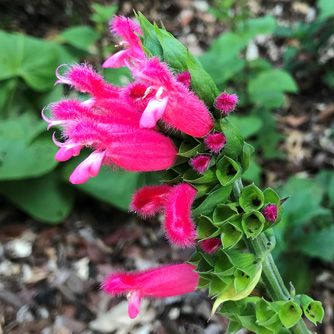
The fury flowers of Salvia oxyphora
Division
Divide herbaceous and semi-herbaceous salvias after winter when frosts are over and the new base shoots are just appearing. Slice the clumps into pieces containing roots and shoots on each and replant. Water in with eco-seaweed.
Pests and Diseases of Salvias
Salvias have very few pest or disease problems when grown in well-drained soil with plenty of sunshine. A few things to watch out for include:
- Caterpillars – the larger leaf types can attract hungry caterpillars. Control with OCP eco-neem.
- Powdery mildew – most common on the annual varieties. Spray with an organic fungicide at the first sign of infection.
- Aphids, mites, whitefly and scale – if these sap suckers appear controlled with OCP eco-oil or OCP eco-neem.
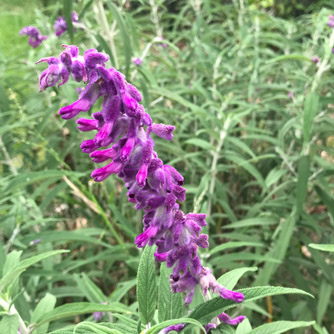
Salvia leucantha


